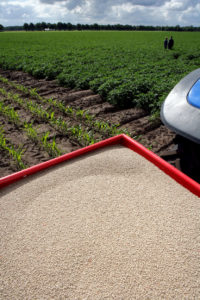How to reduce nitrogen runoff and protect water quality
Nitrogen-rich fertilisers are vital for enhancing soil health and achieving optimal crop yields.
However, when applied in excess or under certain conditions, these nutrients can leach from fields and enter local waterways which results in a series of environmental challenges including:
- Eutrophication: Excess nitrogen can cause overgrowth of algae in water bodies, known as algal blooms.
When the algae dies and decomposes, it consumes oxygen in the water, leading to low oxygen levels, which can be fatal for aquatic life.
- Disruption of aquatic ecosystems: Changes in nutrient levels can shift the balance of species in waterways, leading to reduced biodiversity and imbalances in the food chain.
- Health impacts: High nitrogen levels in drinking water sources can also be harmful to human health, particularly for children.
Here we outline how to use fertilisers while also protecting water quality.
 Right rate, right time
Right rate, right time
By ensuring fertilisers are applied at the right rate and at the right time, farmers can significantly reduce nutrient runoff, save costs, and maintain soil health.
Nutrient applications should be timed according to when crops need them. Use soil tests to determine the exact nutrient needs of your crops and work with your local agronomist who can provide specific advice for your farm.
Weather conditions tend to determine the right time to apply fertiliser. Avoid spreading fertiliser in unfavourable weather conditions such as in wind, high rainfall levels and damp and humid conditions, as runoff can carry nutrients, especially nitrogen (as nitrate) and phosphorus, into nearby water bodies.
Further information on how to apply fertiliser is available here.
Nitrogen-sulphur fertilisers
Nitrogen-sulphur synergy fertilisers like Dynamon can also reduce nitrogen runoff by optimising the crop’s ability to absorb nitrogen.
While nitrogen is one of the key primary nutrients for a crop, an efficient nitrogen fertiliser application also needs secondary nutrients like sulphur.
Increasing a crop’s ability to absorb reduces the total load of fertiliser application, which again can reduce the likelihood of nitrogen runoff.
Buffer strips
UK fertiliser rules state that when spreading fertilisers near watercourses, a 10-metre buffer zone must be maintained.
Integrating pasture adjacent to waterways and as a buffer to cropped arable land, can act to protect and filter field runoff from treated crops, allowing nutrients to be absorbed by the grassland rather than flowing into water courses.
Further information on navigating UK fertiliser rules is available here.

Cover crops
Cover crops, often referred to as “green manure”, are plants primarily grown to offer protective ground cover between arable cropping seasons. Growing cover crops, like clover or rye, between harvest and planting a new crop can help absorb excess nitrogen, reducing the potential for runoff.
Cover crops take up and absorb the residual nutrients left in the soil after the main crop is harvested. By doing so, they reduce the chances of these nutrients, particularly nitrogen, from leaching into waterways.
Conclusion
Farmers play a crucial role not just in producing food, but also in managing the health of our environment. In doing so, they hold both the responsibility and the means to reduce the effects of nitrogen runoff.
By embracing sound practices, we can ensure that our agricultural techniques not only yield optimal crops but also nurture a sustainable environment for future generations.


